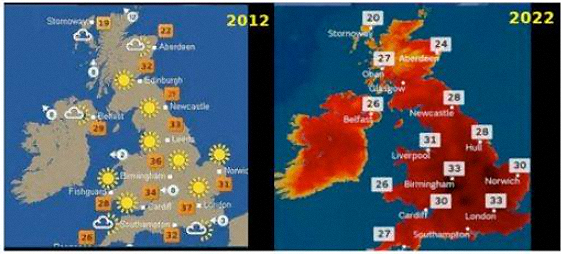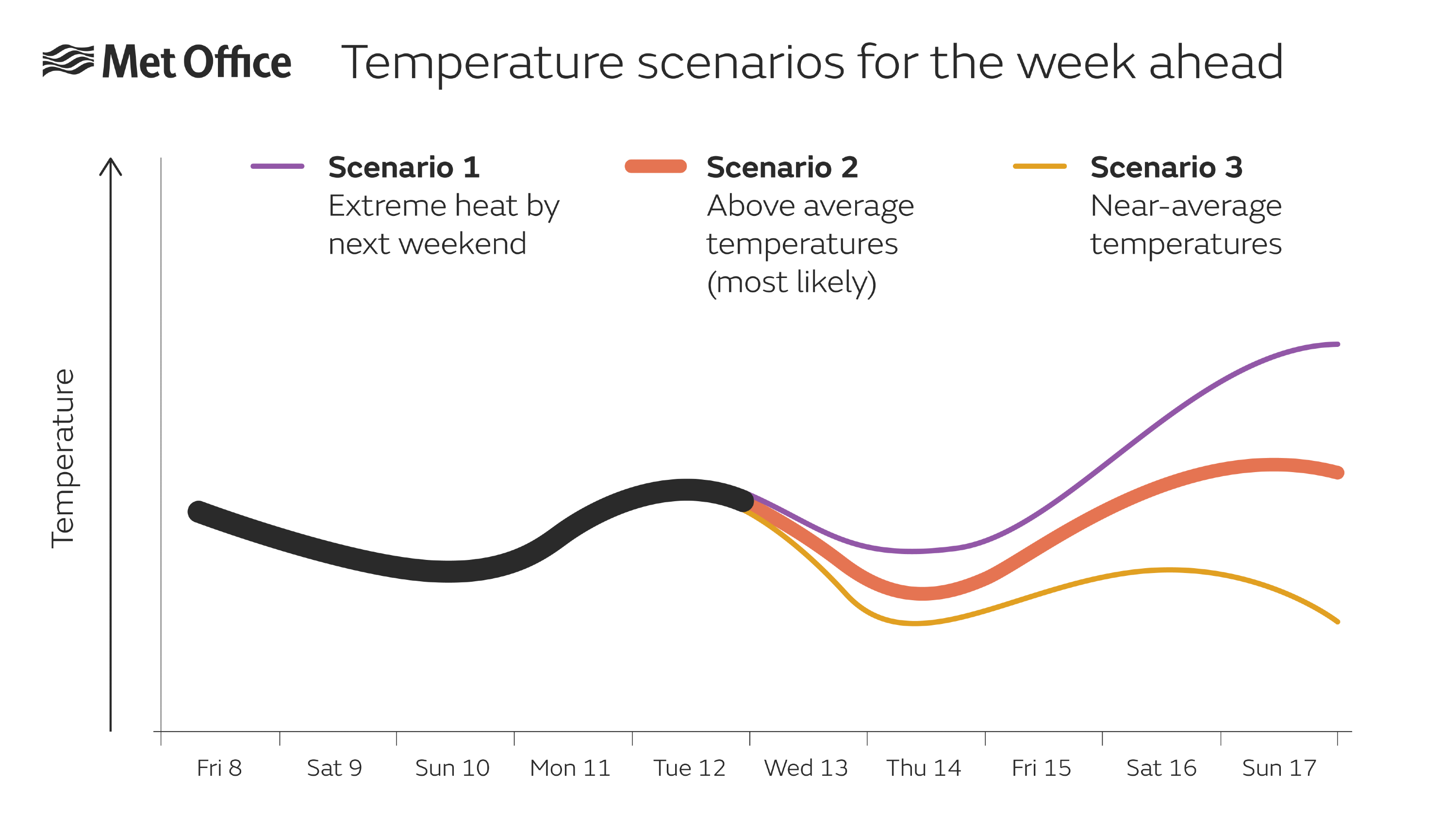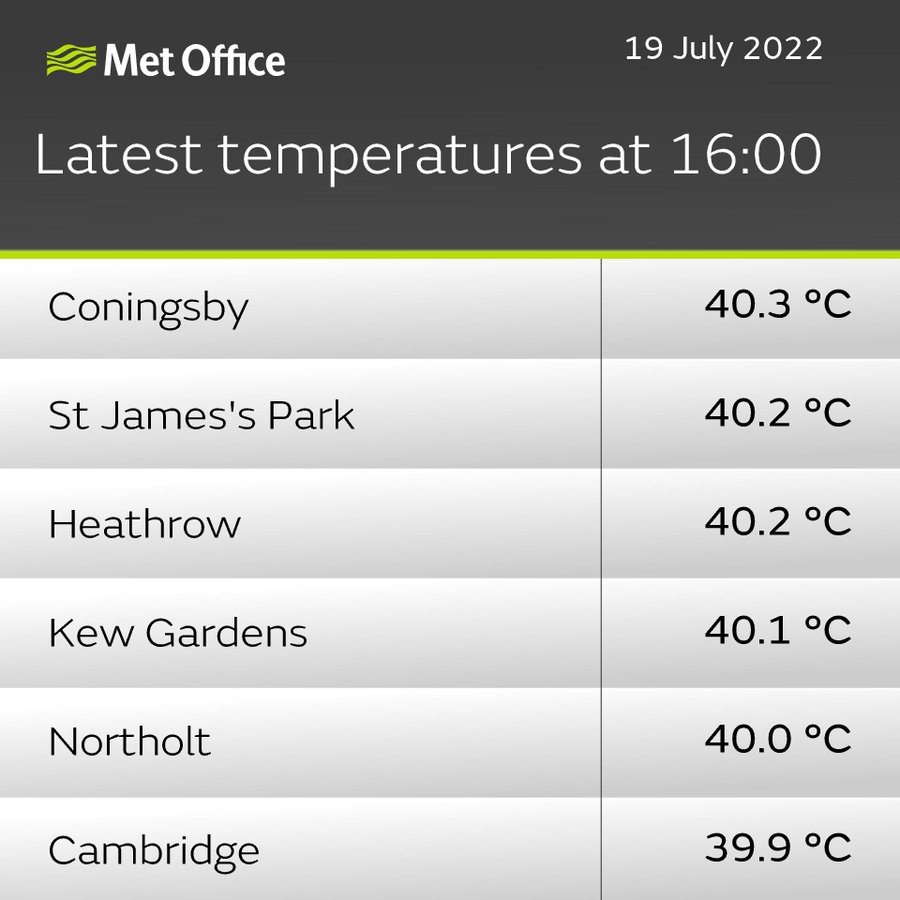Was It Hotter In 1911?
By Paul Homewood
https://www.metoffice.gov.uk/about-us/press-office/news/weather-and-climate/2022/july-heat-review
There has inevitably been a lot of apoplectic reporting about this week’s heatwave in Britain. Everybody from the BBC to the Met Office have been blaming it on climate change, with suitably scary colours to ram the message home:

Comparison of TV weather Maps from the BBC in summer 2012, left, and summer 2022 right. Source: BBC
Courtesy of Climate Realism
But so far I have not seen an objective analysis.
So let’s start with a few simple facts:
1) It was extremely hot for a couple of days this week.
2) The heat was the result of an extremely unlikely set of meteorological conditions – a perfect storm, if you like.
We know this because the Met Office told us so. On July 8th, they announced the possibility of a heatwave a week later. The weather model runs produced a wide band of possibilities, with most predicting similar temperatures to the weekend before, and some even forecasting no heatwave at all. At that stage on a couple of models out of the hundreds run predicted 40C temperatures, which were described by the BBC as “a very tiny possibility”.

https://www.metoffice.gov.uk/about-us/press-office/news/weather-and-climate/2022/heatwave-on-the-way
3) One day’s weather is not “climate”, no matter how much the Met Office argues otherwise. Even if you accept that summer temperatures are a half degree higher than a few decades ago, this only means that we would have had temperatures of 39.5C instead of 40.0C.
But just how exceptional were those temperatures?
Much has been made of the fact that this week’s temperatures beat the previous record by a long way, but exactly the same thing happened in 1911:
The reading of 100F at Greenwich equates to 37.8C, a couple of degrees lower than this week in London. But that is not the whole story.
Temperatures in London and other cities and towns are now significantly affected by the Urban Heat Island effect (UHI). Some studies, for instance here and here, suggest the effect could be 5C to as much as 10C. Whilst UHI has a big effect at night, it is also substantial during sunny days. The map below from the Greater London Authority indicates that much of inner London was 2C hotter during daytime than outlying parts during the summer of 2006:
https://data.london.gov.uk/dataset/london-s-urban-heat-island
Those outlying parts will still of course be somewhat affected by UHI, but even assuming that the UHI effect is only 2C, this immediately accounts for the difference between the temperatures measured in 1911 and this week.
The main factor causing UHI is concrete, along with anthropogenic sources such as cars and air conditioning.
London is experiencing hotter and drier summers that are further impacted by the Urban Heat Island effect (UHI). The UHI can cause London to be up to 10’C warmer than neighbouring rural areas. This is a result of the sun’s rays being absorbed by hard surfaces rather than by vegetation such as trees, plants and grass. Radiation from our hard surfaces is released into the air as heat.
https://www.london.gov.uk/what-we-do/environment/climate-change/climate-adaptation/heat
Clearly the London of 1911 was much different to today, with a much smaller urban footprint.
But the story does not end there. Back in 1911, the skies over London, and indeed much of England were heavily polluted. Not for nothing was London called “The Smoke” in those days. Scientists have long known that these aerosols serve to block incoming solar radiation and temporarily cool the planet. Indeed it was this very factor that set off the global cooling scare in the 1970s.
A recent study has found that global temperatures even now would be 0.5C to 1.1C higher if that pollution were to suddenly disappear. This is a global average, so clearly the effect would be much greater over heavily industrialised areas.
Taken together, UHI and air pollution probably account for all and more the difference between temperatures this week and 1911.
The Summer of 1911
Let’s stay with 1911, because we are not talking just about a few hot days in August. June had a heatwave too, whilst July was “exceptionally warm”:
And the hot weather even extended into September:
Any objective analysis would find that the heat in the summer of 1911 was much more intense and extreme than anything we have seen this year. Strangely though I have not seen any mention of 1911 in the Met Office’s reporting this week!
Comments are closed.













We’ve had a pretty dry year so far and I’m guessing that will have an impact on the potential for a short term hot spell to reach higher temps.
This reminds me that in late May, prior to the start of the 1976 heatwave in June our London office was so cold that we asked for the central heating to be turned back on.
In 1975 we were under six inches of snow on June 1. Admittedly it didn’t survive the morning but it was a marked contrast with the rest of the summer. 1976 overshadows 1975 but that summer was more extreme in some parts of the UK.
Four inches of snow.The week ending with temperatures nearing 70 degrees F.
June of 1975, Pelham 400kv substation.
I recall snow in early June 1976 in Cambridge. It didn’t settle, but it was consistent with what my family have long called D-Day weather.
There may also be some height influence in the area of the North Downs which ,while not particularly high, are above the heat bowl bounded by the Chilterns and the South Downs.
And an alleged “Professor” who heads up the Met Office ramped it up even further with a special lockdown-type TV appearance to tell us that thousands were going to die. She needs to be fired and the Met Office needs to be defunded, not the police. Certainly, no more billion pound computers.
It was hot for a couple of days. My old, thick walled house never even got warmed up. The highest temperature in a N facing bedroom was 26C
In 1975 and even more in 1976 there was considerable heat for long periods.
The climate probably is changing but is it a big deal?
And of course there’s 1976:
As for the Urban Heat Island effect:
As an aside there is this curious thing known as a degree symbol.. ° …how is it that reports back in 1911 managed to put ° after numbers but modern day media seem unable to put ° anywhere at all? Honest it isn’t that difficult! And no it is not pedantry.
Hey I lost the second “S” in my name ….what is going on?
Did it melt in the heat or is it Climate CHANGE?
Sorry about that but I’ve just finished a letter to the editor about some Dr. (medical one?) complaining of my previous letter with a short list of Climate predictions which he thinks is “disputing The Science”.
Just grateful for the sanity of this report, which highlights the ridiculous claims of the BBC et al.
There’s also the issue with the newer Stevenson screens. They run .5 hotter than they should and they were never calibrated with the older ones when replaced.
Another experiment to do!
Compare new & old thermometers & Stevenson screens in the same location.
Run them for a year.
That is serious – new Stevenson screens. That they were not calibrated relative to the old ones is scientifically “careless” to the point of intellectual negligence. If this is true then whoever was responsible must be replaced.
Do you know when this change happened? If you look at the CET temperature record (the only one I trust) there seems to be some suspicious 0.5°C step-change in temperature readings around 1989-1990.
Equally, I believe no validation was ever performed when measurement of atmospheric CO2 levels was moved from the chemical method to the spectrophotometric method! Any good analytical chemist would have called this out as totally unacceptable !
The Climate Emergency of 1911 is recorded here along with all the other Climate Emergencies we have had.
https://historicdroughts.ceh.ac.uk/content/1911-drought
https://historicdroughts.ceh.ac.uk/content/standpipe-drought-1975-1976
Ditto, George.
Well written, Mr Homewood.
I do wonder about this:
‘2) The heat was the result of an extremely unlikely set of meteorological conditions – a perfect storm, if you like.’
The actual meteorological conditions were a cutoff low off Portugal and high pressure in eastern Europe. The effect was to create a nip that pulled the Saharan air mass north to England.
Since England doesn’t get extreme high temps like this very often, I think it fair to say it doesn’t happen very often. But a low off Portugal and high pressure to the east is dirt simple stuff. Ipso facto, I wonder why it doesn’t happen more often. IOW, WHY is it unlikely? What is happening meteorologically that keeps it from happening?
That’s the point though. 40 degrees has always been possible but it required a certain set of very specific conditions. What the Met Office need to demonstrate is that 40 degrees has only become possible because of climate change, but I don’t believe they can do that.
Yes, they would have to explain how “climate change” moved the low here, and the high there, overcoming the barriers that used to keep if from happening.
I’m always surprised that no scientific experimental quantification of UHI, has been carried out.
Same instrument, same Stevenson Screen. Multiple sets positioned in & around a city. Measurements taken over a year.
Because they don’t want to know the answer.
Those different-coloured weather forecast charts are perfectly revealing. Just a decade apart but totally different. Pure propaganda.
I’ve said the same for the famous Reading Uni’ climate stripes by Ed Hawkins. Allocating those shades of blue to red within such a tiny temperature range was sleight of hand propaganda.
Yes, they editorialize by color selection.
Came into Liverpool on Monday from Douglas. The irony of the perpetual news on bbc on the ferry wailing on about the armageddon heatwave and there on the beaches of the Wirral were thousands of Sun worshipers stood shoulder to shoulder like Emperor penguins, not a square foot of sand to be seen. Maybe the public aren’t so taken in after all…..there again.
Just a reminder for those who compare warmer temperatures in the Past. Antarctica was not always where it is now and so ,being closer to the equator, was a warm place. Not recently because it moved https://coolantarctica.com/Antarctica%20fact%20file/History/history_of_the_land_geological-timeline_of_antarctica.php
Another great report Paul. I would be very interested to see a detailed comparison of the heatwaves of 1911, 1976 and 2022 – and possibly for a few other years.
Where can I find and download daily max and min temperatures at specific rural catchments? Surely the Met Office should publish such data but darned if I can find it anywhere!
“Rural stations” not “rural catchments”! Locations in the Midlands region would be particularly of interest as this area was hit hard in the recent heatwave.
The Met Office report is here…
— https://www.metoffice.gov.uk/binaries/content/assets/metofficegovuk/pdf/weather/learn-about/uk-past-events/interesting/2022/2022_03_july_heatwave.pdf
The Met Office don’t make it easy to find (MIDAS is the key search word), but past data can be downloaded for free, after registration, from here:
https://catalogue.ceda.ac.uk/uuid/dbd451271eb04662beade68da43546e1
Registration requires something for “subject”, but degree, supervisor and institution can be left blank.
Data is not very user friendly, annual csv files, and only up to 2020, recent daily data for some stations is available from the GSOD database.
Yes the 1911 summer heatwave was intensely hotter and protracted . It was a trans- Atlantic heatwave …. Something like 41000 French died in the heat and hundreds more in New York …
Have you researched the July 1808 Georgian heatwave Paul ?……Here is an excerpt from an article I read online : ” London is said to have resembled an oven …in the shady side of the streets , the temperature was 100 degrees ….five degrees more than is requisite to melt bees wax ….the honeycomb in bee-hives melted and apparently honey was seen running out from the base of hives . Butter being transported to market turned to oil before reaching its destination “
There is also the fact that dear old “Aunty” didn’t report the concurrent below average temperatures in Eastern Europe – surprise, surprise!!!!!
I noticed Plymouth had a murderous 26degsC with rain
I think this is essentially moot. We know the high temperatures had nothing to do with climate change but with other factors – the Met Office model confirms that. What the model shows is that small changes in those factors can make large differences in UK temperatures. The Met Office models differed by at least five degrees. It is therefore perfectly possible to have had 40 degrees at any time in the past – unless the Met Office can demonstrate that their model of the weather phenomenon somehow requires climate change.
Put simply, record temperatures like this have always been possible and were going to happen at some point. It’s feasible that higher temperatures are also perfectly possible without climate change being a factor.
Uk Met office lie monkeys cooled 1911 in Jan 2020. The whole scenario is disgusting. The dataset_5km URL is pre jan 2020 https://www.metoffice.gov.uk/pub/data/weather/uk/climate/datasets_5km/Tmean/date/UK.txt https://www.metoffice.gov.uk/pub/data/weather/uk/climate/datasets/Tmean/date/UK.txt
Rgds Andrew
Final analysis: Does anyone know how many Brits were killed by the heat last week?
What are the odds that every one of those top temperatures would be an airfield or a city. What are the odds that we always build airfields at the warmest places in the country?
Speaking of London and the UHIE.
I am in the open country to the south of Croydon and of an evening travelling from a point west of Croydon in the 7 area I have seen my car thermometer change by 5 degrees C during the course of a 45 minute drive.
Cherrypicking the hottest MOMENT of the day is NOT science
It’s PR
Here in the heatwave hot temps were almost always accompanied by cooling wind
so that is different from a till humid day
BTW has anyone seen a heatwave body count ?
Did anyone name any of the thousands that died a they predicted ?